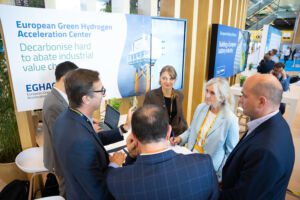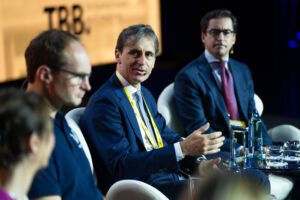Where do we stand on economic growth, geopolitical resilience, and clean energy transition: Trilemma or opportunity?
October 25, 2024
- To ensure economic growth, geopolitical resilience, and the clean energy transition serve as opportunities today, we require leadership, collaboration, and a willingness to roll up our sleeves and make it happen.
- AI developments, hydrogen’s initial signs of success, ESS growth, and PV’s reshoring readiness speak for economic growth.
- Fair competition is a key success driver of global decarbonisation.
- Regulatory readiness and continued focus on optimisation have paved the way for cleantech innovations.
- The Business Booster is the leading platform to accelerate the meetings, discussions, and actions needed for the clean energy transition.
The Business Booster (TBB) 2024 returned to Barcelona in spectacular fashion, uniting over 1,700 attendees from across the global energy landscape for two days of fruitful dialogues, innovation collaborations, and inspiration.
This year’s event highlighted a critical focus on balancing economic growth, geopolitical resilience, and the clean energy transition. The dialogues centred around collaborations, taking advantage of innovative technologies’ opportunities, and the role the broader ecosystem must play.
The need and momentum for growth are strong
 Elena Bou, InnoEnergy’s Innovation Director, spoke about Europe’s cleantech leadership, noting that 40% of emerging clean technologies globally originate from Europe. Bou stressed the importance of maintaining momentum, as Europe now leads 43% of global climate tech investment. “We are on track, but as a global community, much work remains to be done,” said Bou, calling for Europe to maintain its competitive edge while fostering fair competition.
Elena Bou, InnoEnergy’s Innovation Director, spoke about Europe’s cleantech leadership, noting that 40% of emerging clean technologies globally originate from Europe. Bou stressed the importance of maintaining momentum, as Europe now leads 43% of global climate tech investment. “We are on track, but as a global community, much work remains to be done,” said Bou, calling for Europe to maintain its competitive edge while fostering fair competition.
One key energy driver is the growth of AI. “We cannot sustain the growth of data centres only by efficiency improvements,” explained Herve Hellez, Power Europe and France Strategy Leader at Schneider Electric. “We must look at modernising them for more capacity and optimising grid usage.”
With AI’s developments, its focus should also be as part of the sustainable energy solution. Jef Caers, Founder of Stanford MineralX and Professor of Earth and Planetary Sciences at Stanford University, said, “We need more AI that recommends action and not just prediction.”
Another large growth opportunity lies in the hydrogen industry. In this nascent industry, financing must be linked to off-takers on a 15-20-year timeframe to obtain bankability. With the long lead time, a key success factor is continuous de-risking of innovative climate technologies and optimising running costs using, for example, simulations to predict and improve outcomes. A strong ecosystem collaboration is necessary, including a wide range of multifaceted partnerships between industry, academia, and politics.

“We are starting to see how hydrogen can impact the energy sector in examples such as H2 Green Steel (now Stegra) in Sweden and the NEOM project in Saudi Arabia,” said Carina Krastel, Managing Director of the European Green Hydrogen Acceleration Center, operated by InnoEnergy. “They managed to obtain a final investment decision due to strong offtake alignment and risk sharing amongst a diverse range of partners.”
Despite a slower growth pace than before, the battery industry was highlighted as central to Europe’s economic growth. While the demand for electrical vehicles (EVs) is slowing, demand for stationary energy storage systems (ESS) accelerates. With China and the US leading in ESS, Europe faces both an opportunity and a challenge to stay competitive. Currently, scaling production, geopolitical dependencies, and funding gaps persist. “Through sustainable product design, regulatory alignment, and public-private collaboration, Europe has the potential to transform its battery industry into a model of resilience, helping to meet clean energy goals while strengthening its geopolitical and economic position”, said Thore Sekkenes, EBA programme Director at EIT InnoEnergy.
 The EU and its member states are actively examining reshoring industrial photovoltaic (PV) manufacturing capabilities, aiming to rebuild up to 30 GW of industrial capacity. While achieving this is challenging because of China’s dominance, Europe’scommitment and the necessary elements are all in place. “There is alignment in ambition from EU and Member States, readiness from the EU to put together levers to support this, and public financing and skills development,” said Penelope Nabet, EU Public Affairs Manager at EIT InnoEnergy. “The main challenge is to implement correctly and quickly.”
The EU and its member states are actively examining reshoring industrial photovoltaic (PV) manufacturing capabilities, aiming to rebuild up to 30 GW of industrial capacity. While achieving this is challenging because of China’s dominance, Europe’scommitment and the necessary elements are all in place. “There is alignment in ambition from EU and Member States, readiness from the EU to put together levers to support this, and public financing and skills development,” said Penelope Nabet, EU Public Affairs Manager at EIT InnoEnergy. “The main challenge is to implement correctly and quickly.”
Not just at the EU level, but Member States are also responding to capture this potential. “We are creating the conditions for the investment in the manufacturing of equipment linked to the energy transition,” explained Miguel Rodrigo Gonzalo, Director of Knowledge, Development of New Business Models and Competitiveness of the Spanish energy agency IDAE.
Geopolitical resilience: Cleantech innovations as a financial driver and shifting to a strategic approach
Europe’s ability to secure energy independence was top of mind. Maroš Šefčovič, Executive Vice-President of the European Commission, highlighted Europe’s success in reducing reliance on Russian gas imports from 45% in 2021 to 15% today. This achievement underlines Europe’s commitment to reducing external energy dependencies and strengthening its geopolitical resilience. “Competitiveness and decarbonisation go hand in hand,” Šefčovič explained. “We must ensure private financing goes where it is needed to maintain our position at the forefront of the clean energy transition.”
Kerstin Jorna, Director-General at European Commission DG GROW, explained the thinking behind bolstering European green industrial policy: “For a long time, our focus has been regulation and grants. The EU has developed to understand the business case. It was too slow on cleantech. That is why we adopted the Net Zero Industry Act.”
 Europe’s financial institutions increasingly focus on backing innovations contributing to long-term energy independence and security. Regarding financing Europe’s industrial champions, Alessandro Izzo, Director of Growth Capital and Project Finance at EIB, commented, “At the EIB, there has been a paradigm shift in how we deploy our capital. Cleantech innovation is now a major driver for us.”
Europe’s financial institutions increasingly focus on backing innovations contributing to long-term energy independence and security. Regarding financing Europe’s industrial champions, Alessandro Izzo, Director of Growth Capital and Project Finance at EIB, commented, “At the EIB, there has been a paradigm shift in how we deploy our capital. Cleantech innovation is now a major driver for us.”
The Made-in-Europe strategy for sustainable manufacturing was spotlighted in a discussion about how reshoring the production of critical green technologies, such as batteries and solar panels, could enhance Europe’s global competitiveness. Commenting on this topic, Benoit Lemaignan, CEO of Verkor, stressed, “Execution is the core of everything, and Europe must transition from an opportunistic approach to a strategic one to produce true industrial champions.”
Speaking on green industrial policy, Franck Neel, Board Member at OMV Petrom, explained, “The EU’s Fit for 55 package, notably the Renewable Energy Directive (RED) and targets on ESAF have helped us make a business case for the transition. Permitting is still a challenge.”
“GravitHy’s business case is greatly supported by EU regulation,” explained José Noldin, CEO of GravitHy. “Going forward, we must not lose the ambition on CBAM, there has to be a cost to polluting to level the playing field for green frontrunners.”
“Now is the time to lead the energy transition change”
Setting the tone for the clean energy transition, “It is much easier to go second, but now is the time to lead the energy transition change, roll up our sleeves, and keep going,” Lewis Pugh, Endurance swimmer and UN Environment Programme Patron of the Oceans, said in his keynote speech. “Our world is changing, and we need to take serious action. We will be with you every single stroke.”
Continuing that tone, Jorna explained, “Everybody here is walking on the transition, but your shoes hurt. Three pain points we want to address are 1) better on grid capacity, 2) derisking – more leverage with public and private, 3) execution: implementation at speed using digitalisation.”
 The transition discussions also focused on how Europe can balance decarbonisation efforts with industrial competitiveness. Gwenaelle Avice Huet, Executive Vice President of Europe Operations at Schneider Electric, highlighted the need to reskill 80 million workers by 2030, particularly in areas like hydrogen, electrification, and energy efficiency.
The transition discussions also focused on how Europe can balance decarbonisation efforts with industrial competitiveness. Gwenaelle Avice Huet, Executive Vice President of Europe Operations at Schneider Electric, highlighted the need to reskill 80 million workers by 2030, particularly in areas like hydrogen, electrification, and energy efficiency.
Avice also pointed out Europe’s lag in R&D investment: “Europe is spending 2.2% of GDP on R&D, but compared to South Korea, Japan, and the US, we are far behind. This must be a wake-up call if we are to maintain our leadership.” While Europe is strong in technology development, protecting its innovation and know-how is crucial for maintaining leadership and competing fairly in the clean energy space.
As demonstrated by the start-ups and scale-ups attending TBB, the technologies exist, and enabling more of them to scale is the next opportunity to meet Europe’s decarbonisation goals.
TBB: Accelerating the speed of action
Having hosted the first editions of The Business Booster in 2013, 2014, and 2016, Barcelona’s role in this year’s conference felt like a full-circle moment. As the second most popular city for start-up founders in Europe, with an ecosystem valued at $21 billion, the stage was set for an impactful event with a clear theme of accelerating Europe’s green revolution and turning innovation into impact.

With 3,500+ meetings between entrepreneurs, investors, policymakers, and industry leaders, TBB reinforced Europe’s leadership in the clean energy transition and highlighted the groundbreaking technologies paving the way for a sustainable future.
Diego Pavia, CEO of InnoEnergy, spoke about InnoEnergy’s recent achievement, stating, “Achieving unicorn status brings both pride and responsibility. But we didn’t reach this point on our own: it is thanks to the ecosystem. Together, we are achievers. This is just the beginning of a marathon, and in five years, we aim to be a decacorn.”
The clean energy future: A collaborative act of growth, resilience, and innovation
 The path forward hinges on collaboration. Pavia emphasised that success will require a united effort from industries, policymakers, and innovators. InnoEnergy and its ecosystem drive this transformation, offering the infrastructure to scale green solutions.
The path forward hinges on collaboration. Pavia emphasised that success will require a united effort from industries, policymakers, and innovators. InnoEnergy and its ecosystem drive this transformation, offering the infrastructure to scale green solutions.
The clean energy transition is not just a challenge but a significant opportunity to reshape the economic and energy landscape. The global energy shift will happen by balancing economic growth, geopolitical resilience, and the clean energy transition.
Europe has the tools for success. However, the focus must now shift from ambition to strategy and action. Ultimately, the solution lies in working together (startups, corporates, investors, and governments) toward common goals. With strategic investment and collaboration, we can turn this transition into an opportunity rather than a trilemma, ensuring long-term prosperity and energy leadership in the future of global clean energy.
View the TBB.2024 photo album and be sure to pre-register for The Business Booster 2025 in Paris on 7-8 October.